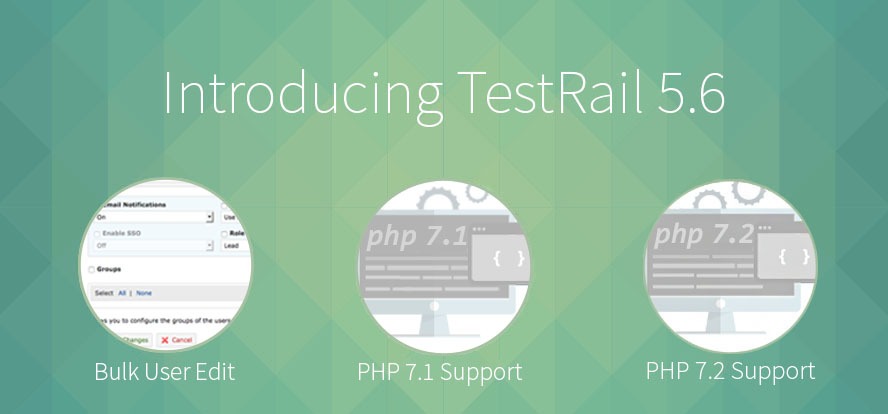We’re pleased to announce that TestRail 5.6 has been released and is available in our hosted (cloud) environment and for download by server installation customers.
PHP 7.1 & 7.2 Support
As of TestRail 5.6, we can support installation in PHP 7.1 and 7.2 environments. This is an important update since, as many of you are no doubt aware, 5.6 and even 7.0 are no longer actively supported PHP versions, with security support elapsing soon also – on the 31st and 3rd December respectively.
Please note that as of this release, we are deprecating support for running TestRail in a PHP 5.6 environment. TestRail is fully supported when running in PHP 7.0, and now PHP 7.1 & 7.2 environments too.
If you need to upgrade your installation environment, please read our documentation on doing so here: (How To) Upgrade TestRail Server from PHP 5.6 to PHP 7.x
Bulk User Updates
As part of our ongoing commitment to making life easier for TestRail administrators, we’ve added a bulk update feature to the user management area in the administration console. If you find yourself having to make changes to large numbers of users on a regular basis, we expect you’ll be grateful for the ability to carry out those changes in bulk – rather than on an individual basis.
(This feature was originally planned for part of the SAML 2.0 Single Sign On functionality we intended to include within the 5.6 release. Unfortunately, due to some dependent system issues – we’ve had to push that functionality back to TestRail 5.7, which we expect to release along with some other big new features, early in the new year).
Bug Fixes
Whoops! Occasionally we make mistakes… In 5.6 we’ve tried to rectify a few of them:
- Completed projects count bug – for some reason, once you got over 25 projects, our project counter stopped counting them. Now, it does.
- Forget user administrator bug – when we provided administrators with the capability to “forget” users as part of our GDPR package, they also gained the ability to forget themselves. Doh! Our support team will be very happy to learn that administrators cannot forget themselves any longer.
- Test plan assignee bugs – changing assignees within test plans was problematic. As of 5.6, when you change the user to whom a run is assigned in the UI, the individual test assignees will get updated correctly too.
- Missing reports issue for some cloud customers – ironically, as a result of our improving the overall performance of our cloud infrastructure, we exposed an issue whereby some customers were experiencing loss of their reports. This was due to a bug in the database that manifested itself when lots of report jobs were being run by the background task at high speed. Now fixed!
- Jira user email address validation fix – Atlassian decided to stop using usernames for authentication purposes, but our integration still required them and wouldn’t allow you to add email addresses instead due to historic validation rules. We’ve removed those now, so your Jira integrations should be footloose and fancy free from here on in.
for QA and Development Teams

Upgrading to TestRail 5.6
Upgrading to TestRail 5.6 is easy and if you benefit from any of the above improvements, we would recommend upgrading. We’ve included all the required details below to get TestRail 5.6 up and running, depending on the edition you use:
- TestRail Cloud: Most accounts of TestRail Cloud already use the new version. Any accounts which don’t already have it can expect the upgrade over the next few days or so.
- TestRail Server (licensed): You can download the latest version or renew your support plan from your customer portal account. Please remember to backup your database before updating!
- TestRail Server (trial): Please contact us to upgrade your download trial.
- New User: Want to try TestRail? Get a free trial.
We hope you’re well pleased with all the work we’ve been doing. If you have any questions or feedback about the new version, please let us know!
Post by Simon Knight, Gurock Product Manager. Follow him on Twitter or LinkedIn.
Cross-Technology | Cross-Device | Cross-Platform




